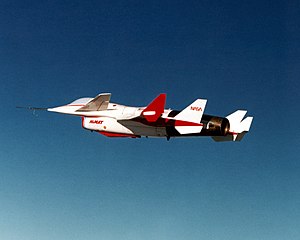Rockwell HiMAT
| Rockwell HiMAT | |
|---|---|

|
|
| Type: | Experimental airplane |
| Design country: | |
| Manufacturer: | |
| First flight: |
July 1979 |
| Commissioning: |
July 1979 (start of testing) |
| Production time: |
no series production |
| Number of pieces: |
2 |
The Rockwell RPRV-870 HiMAT ( Hi ghly M aneuverable A ircraft T echnology) was an experimental aircraft, consisting of a development program of the NASA emerged. The HiMAT program was carried out as part of a United States Air Force tendering process . The main aim was to develop technologies for future fighter aircraft . In addition, the program included the development of canard wings, fully digital aircraft control (including FADEC ), composite materials , graphite and glass fiber reinforced plastic , unmanned aircraft , virtual reality for pilots and winglets . In addition, the aim was to develop a fighter aircraft with an unprecedented degree of maneuverability ("Highly Maneuverable"). Rockwell International eventually won the tender process with its design.
Technical specifications
| Parameter | Data |
|---|---|
| crew | - |
| length | 6.86 m |
| span | 4.75 m |
| height | 1.31 m |
| Takeoff mass | 1542 kg |
| Top speed | Mach 1.6 (1960 km / h) |
| Engines | 1 × General Electric J85 -21 Turbojet with 22.2 kilonewtons of thrust |